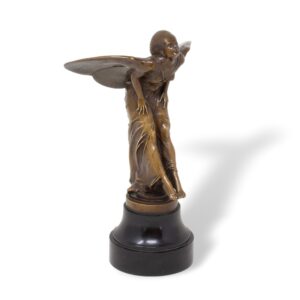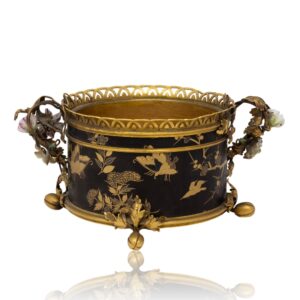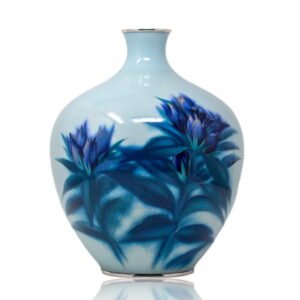-
New

Italian Silver and Guilloche Enamel Box by Salimbeni
£2,000.00 -
New

French Limoges Enamel Jewellery Box, Ormolu Casket
£1,950.00 -
New

French Bronze of Crouching Venus on Turtle after Antoine Coysevox, Circa 1880
£2,250.00 -
New

French Art Deco Bronze Woman with Flowers by Bouraine, Cast by Goldscheider
£2,000.00 -

French 19th Century Bronze Figure “Repousseur de la Renaissance” by Ernest Rancoulet
£3,500.00 -

Austrian Bronze Sculpture of Psyche “Butterfly Woman” by Franz Mazura
£2,250.00 -

Pair of French Bronze Ormolu Tazza Centrepieces with Hunting Dogs
£3,250.00 -

Japanese Simulated Iron Bronze Vase by Miyabe Atsuyoshi, Meiji Period, circa 1890
£3,500.00 -

Black Forest Carved Walnut Wall Plaque, Eagle with Prey, circa 1900
£1,750.00 -

Japanese Bronze Figure by Miyao Eisuke, Meiji Period, Circa 1890
£7,500.00 -

French Japanned Jardinière by Boin-Taburet, Ormolu and Porcelain Flowers, Circa 1890
£1,500.00 -

Pair of French Empire Bronze and Mercury Gilt Candelabra, circa 1815
£3,250.00 -

French Bronze Pheasant and Weasel by Jules Moigniez
£3,800.00 -

French Sèvres Porcelain Box with Château des Tuileries Mark
£2,800.00 -

Japanese Cloisonné Enamel Vase by Ando Company, Showa Period
£2,250.00 -

Japanese Pair of Satsuma Vases by Kanzan for the Yasuda Company
-

Sevres Bleu Lapis Enamel Box
-

Sevres Bleu Celeste Enamel Box
-

Memento Mori Bronze Vulture and Skull by Bohuslav Schnirch
£1,200.00 -

Grand Tour Bronze of Mithras Slaying the Bull
-

Miniature Napoleonic Military Hats Charles Sandré
£5,500.00
Decorative Antiques
Decorative antiques are a diverse category of collectable items that go beyond functionality to serve as statement pieces, enhancing spaces and reflecting personal style. The collection at Jacksons Antique features an impressive array of decorative items, including Black Forest carvings and unique silver pieces, each capable of becoming a centrepiece in homes and workspaces alike.
Historical Significance and Cultural Context
Decorative antiques showcase the rich cultural backgrounds from which they originate. The collection at Jacksons Antique exemplifies this diversity, featuring Japanese mixed metal pieces, such as the Shakudo Mixed Metal Vase by Shuho, European craftsmanship like the French Ormolu and Enamel Jewellery Box, and Swiss Black Forest carvings.
Many of these items were created during periods of significant artistic development and cross-cultural exchange, particularly during the 18th and 19th centuries when global trade routes expanded.
Numerous decorative antiques emerged from specific artistic movements or reflected the societal values of their times. For instance, Grand Tour marble plaques originated from a European tradition where young aristocrats embarked on educational journeys through Europe. Similarly, Japanese cloisonné pieces represent the artistic renaissance of the Meiji Period, a time when Japan opened up to Western influence.
Types and Distinctive Characteristics
Decorative antiques come in a wide variety of items, each with its own unique characteristics:
Antique Mirrors
These serve as stunning focal points in any room, adding elegance and depth to spaces. Whether they are gilded French mirrors or simple overmantel designs, antique mirrors reflect light and bring an old-world charm to contemporary settings.
Antique Clocks
From longcase (grandfather) clocks to ornate mantel timepieces, these items combine mechanical ingenuity with decorative craftsmanship. For example, the George Betjemann Novelty Drum Clock at Jacksons exemplifies how timepieces can also serve as conversation pieces.
Antique Chandeliers and Lighting
Antique lighting instantly elevates a room’s ambience. Whether made of crystal, iron-cast in medieval styles, or designed with an Art Deco flair, these fixtures make a statement. Antique ceramic lamp bases paired with modern shades can create a harmonious blend of traditional and contemporary styles.
Period Furniture
Well-crafted period furniture pieces add warmth and character to homes. Tables, seating, and dressers are especially popular as “forever pieces” that can transition from one home to another. The renewed interest in “brown furniture” (traditional wooden pieces) reflects a growing awareness of the sustainability of antique furniture.
Decorative Metalwork
Items such as the Japanese silver and shibuichi box by Hiroteru or the Chinese silver box by Hung Chong showcase the exceptional craftsmanship found in metalwork from different cultures.
Ceramics and Porcelain
Delicate teacups, vases, and figurines serve as wonderful decorative accents. The Japanese cloisonné enamel vases in Jackson’s collection exemplify the artistic mastery and technical skill required to create these pieces.
Evolution Over Time
Decorative antiques have experienced varying levels of popularity throughout history. After falling out of favour in the 1990s due to the rise of mass-produced furniture, brown furniture and other decorative antiques have seen a resurgence as consumers become more conscious of sustainability issues and seek uniqueness in their homes.
The concept of “decorative antiques” has evolved to encompass not only high-end, expensive pieces but also more accessible items that add character to modern interiors. The maximalist trend has further fueled interest in incorporating decorative antiques within contemporary spaces.
Contemporary Relevance
In modern interior design, decorative antiques serve several important purposes:
- Sustainability: Antique furniture is a sustainable choice compared to disposable, mass-produced alternatives.
- Uniqueness: In an era of mass production, decorative antiques offer one-of-a-kind character and craftsmanship.
- Storytelling: Each piece carries its own history, adding depth and personality to interiors.
- Investment Value: Quality decorative antiques often retain or even increase in value over time.
Incorporating Decorative Antiques in Modern Homes
For those living in contemporary homes, thoughtfully integrating decorative antiques requires careful consideration:
- Select Pieces You Love: Rather than focusing solely on whether an item matches your existing décor, choose pieces that resonate with you personally. Use them to add depth and texture to modern spaces.
- Layer Antique Pieces: The trend towards maximalism encourages layering larger antique furniture with smaller decorative items and textiles, allowing different periods and aesthetics to harmonise.
- Start Small: Begin with accessories, such as bon bon dishes or antique photo frames, before introducing larger, statement pieces.
- Consider Upcycling: If dark wood furniture feels overwhelming in a space, think about refreshing it while preserving its character.
- Mix Modern and Antique Elements: Create balance by pairing contemporary items with antiques, such as using modern lampshades on antique bases.
Decorative Antiques at Jacksons Antique
Decorative antiques provide a timeless way to add charm, character, and a sense of history to both traditional and contemporary interiors. From exquisite Japanese metalwork and enamel pieces to European silver and furniture, these items connect us to traditional craftsmanship while offering sustainable alternatives to modern, mass-produced goods. As interest in individuality and sustainability continues to grow, decorative antiques remain relevant, enabling homeowners to create spaces that are not only beautiful but also meaningful and unique.




